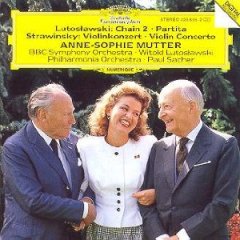Anne-Sophie Mutter - Lutoslawski - Chain 2, Partita, Strawinsky - Violin Concerto (1988)
Anne-Sophie Mutter - Lutoslawski - Chain 2, Partita, Strawinsky - Violin Concerto (1988)

Igor Stravinsky (1882-1971) Violin Concerto in D major 1. Toccata 5:51 2. Aria I 4:09 3. Aria II 5:13 4. Capriccio 5:49 Anne-Sophie Mutter, violin Philharmonia Orchestra Paul Sacher, conductor Witold Lutosławski (1913-1994) Partita for violin, orchestra & obbligato piano "For Anne-Sophie Mutter" 5. Allegro giusto 4:14 6. Ad libitum 1:12 7. Largo 6:22 8. Ad libitum 0:47 9. Presto 3:51 (Erstaufnahme / First Recording / Premier enregistrement) Chain 2, dialogue for violin & orchestra Ad Libitum "For Paul Sacher" 10. Ad libitum 3:48 11. A battuta 4:58 12. Ad libitum 4:58 13. A battuta—Ad libitum—A battuta 4:27 (Erstaufnahme / First Recording / Premier enregistrement) Anne-Sophie Mutter, violin BBC Symphony Orchestra Witold Lutoslawski, conductor
This Deutsche Grammophon pairs works by Igor Stravinsky and Witold Lutoslawski, displaying Anne-Sophie Mutter's strong interest in 20th century repertoire. Paul Sacher conducts Philharmonia in the Stravinsky, while Lutoslawski conducts the BBC Symphony Orchestra in his pieces. The Lutoslawski was subsequently reissued in the label's "Echo 20/21" series, while the Stravinsky appeared again on a 2005 disc.
Igor Stravinsky's Violin Concerto (1931) was written at the height of his neoclassical period. It is in four movements of which the outer two are extrovert, while the inner two (called "arias") more subtle and mysterious, though all begin with the same D-E-A chord. I have a peculiar relationship with Stravinsky, as I find that I enjoy his music when it's playing, but nothing calls me back to it. These foursquare, slightly vulgar rhythms are fun, but I don't detect any mystery which makes me want to explore the piece again and again. Here Paul Sacher conducts Philharmonia, taking a more meditative pace in the arias than I've heard elsewhere.
For over two decades Witold Lutoslawski wrote music where the harmonies were derived from 12-tone chords and for much of the work the ensemble was left to play without the conducted to produce unusual quasi-aleatoric textures. In the early 1980s, however, he began to revert to a rather more conventional style, abandoning total chromaticism and writing fewer ad libitum sections.
In "Chain 2" (1984), a "dialogue for violin and orchestra" one still feels that the form is boundlessly expanding, avoiding any stale constraints of classicism. The title refers to the composer's new technique of beginning new sections before the last is fully completed, giving the work a certain momentum that propels the music forward. While emphatically not a violin concerto (he was at work on a piece earning such a name just before his death), Lutoslawski's love for the instrument is so great that the work displays all manner of violin technique and mood.
Lutoslawski was so impressed with Anne-Sophie Mutter's performance in the premiere of "Chain 2 " that he orchestrated a work originally for violin and piano especially for her. The resulting "Partita" (1988) immediately strikes the listener who has followed Lutoslawski's work chronologically as strait-jacketed. The occasionally interludes for solo violin and piano don't are interesting. But that doesn't change the fact that the main of the work finds inspiration in Baroque music, and even if there are no major or minor keys, the work still approximates a sort of stale tonality.
The performances and sound quality are excellent, even if these aren't the most interesting pieces from the two composers. If you're interested in this music, I'd suggest going for the reissues, as the Stravinsky reissue also has an excellent Dutilleux premiere, while the Lutoslawski reissue combines Mutter's recordings with the dedicatee's performance of the Piano Concerto. --- Christopher Culver, amazon.com
download (mp3 @160,192 kbs):
uploaded yandex 4shared mega solidfiles zalivalka cloudmailru filecloudio oboom
Last Updated (Thursday, 05 February 2015 10:41)








